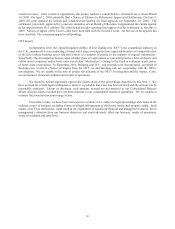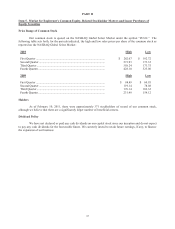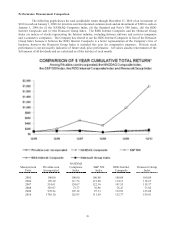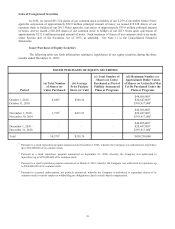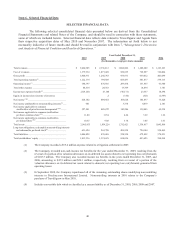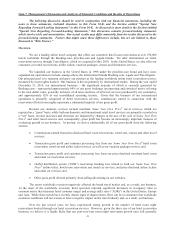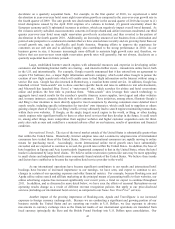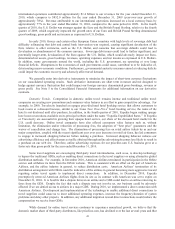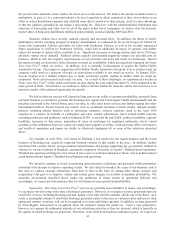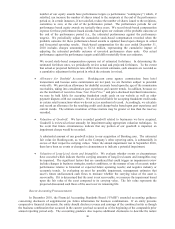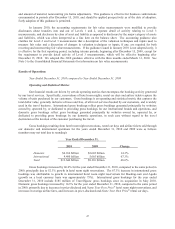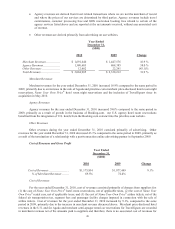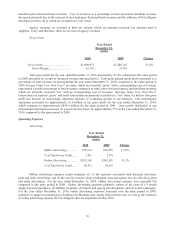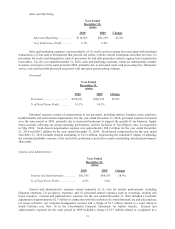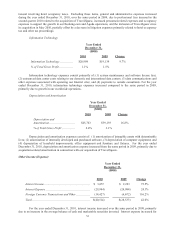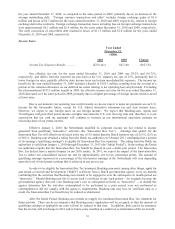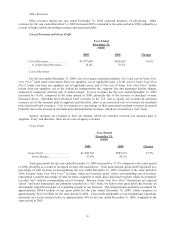Priceline 2010 Annual Report Download - page 120
Download and view the complete annual report
Please find page 120 of the 2010 Priceline annual report below. You can navigate through the pages in the report by either clicking on the pages listed below, or by using the keyword search tool below to find specific information within the annual report.46
number of our equity awards have performance targets (a performance “contingency”) which, if
satisfied, can increase the number of shares issued to the recipients at the end of the performance
period or, in certain instances, if not satisfied, reduce the number of shares issued to the recipients,
sometimes to zero, at the end of the performance period. The performance periods for our
performance based equity awards are typically three years. We record stock-based compensation
expense for these performance-based awards based upon our estimate of the probable outcome at
the end of the performance period (i.e., the estimated performance against the performance
targets). We periodically adjust the cumulative stock-based compensation recorded when the
probable outcome for these performance-based awards is updated based upon changes in actual
and forecasted operating results. Stock-based compensation for the year ended December 31,
2010 includes charges amounting to $13.4 million, representing the cumulative impact of
adjusting the estimated probable outcome of unvested performance share units. Our actual
performance against the performance targets could differ materially from our estimates.
We record stock-based compensation expense net of estimated forfeitures. In determining the
estimated forfeiture rates, we periodically review actual and projected forfeitures. To the extent
that actual or projected forfeiture rates differ from current estimates, such amounts are recorded as
a cumulative adjustment in the period in which the estimate is revised.
x Allowance for Doubtful Accounts. Booking.com earns agency commissions from hotel
transactions and because some commissions are not paid, we are therefore subject to potential
write-offs. We provide an allowance for doubtful accounts based upon the age of the commission
receivables, taking into consideration past experience and current trends. In addition, because we
are the merchant of record in Name Your Own Price ® and price-disclosed merchant transactions,
we may be held liable for accepting fraudulent credit cards on our website as well as other
payment disputes with our customers. We are also held liable for accepting fraudulent credit cards
in certain retail transactions when we do not act as merchant of record. Accordingly, we calculate
and record an allowance for the resulting credit card charge-backs based upon past experience and
current trends. The ultimate resolution of these matters may be greater or less than the reserves
recorded.
x Valuation of Goodwill. We have recorded goodwill related to businesses we have acquired.
Goodwill is reviewed at least annually for impairment using appropriate valuation techniques. In
the event that future circumstances indicate that any portion of our goodwill is impaired, an
impairment charge would be recorded.
A substantial amount of our goodwill relates to our acquisition of Booking.com. The estimated
fair value for Booking.com, as well as the Company’s other reporting units, is substantially in
excess of their respective carrying values. Since the annual impairment test in September 2010,
there have been no events or changes in circumstances to indicate a potential impairment.
x Valuation of Long-Lived Assets and Intangibles. We evaluate whether events or circumstances
have occurred which indicate that the carrying amounts of long-lived assets and intangibles may
be impaired. The significant factors that are considered that could trigger an impairment review
include changes in business strategies, market conditions, or the manner of use of an asset; under
performance relative to historical or expected future operating results; and negative industry or
economic trends. In evaluating an asset for possible impairment, management estimates that
asset’s future undiscounted cash flows to measure whether the carrying value of the asset is
recoverable. If it is determined that the asset is not recoverable, we measure the impairment based
upon the fair value of the asset compared to its carrying value. The fair value represents the
projected discounted cash flows of the asset over its remaining life.
Recent Accounting Pronouncements
In December 2010, the Financial Accounting Standards Board (“FASB”) amended accounting guidance
concerning disclosure of supplemental pro forma information for business combinations. If an entity presents
comparative financial statements, the entity should disclose revenue and earnings of the combined entity as though
the business combination that occurred in the current year had occurred as of the beginning of the comparable prior
annual reporting period only. The accounting guidance also requires additional disclosures to describe the nature


